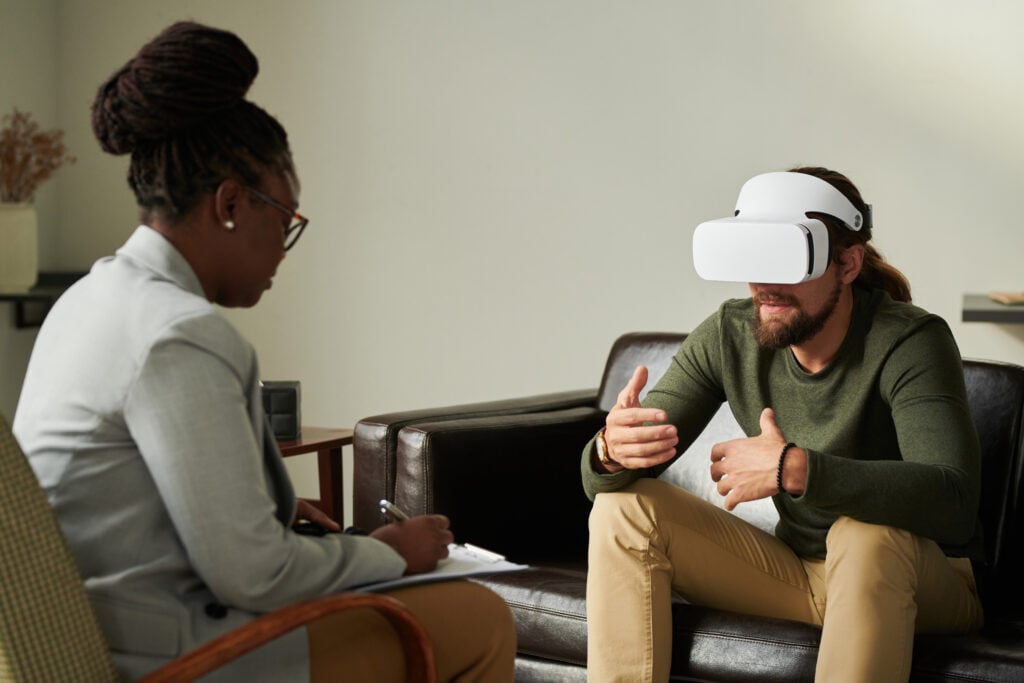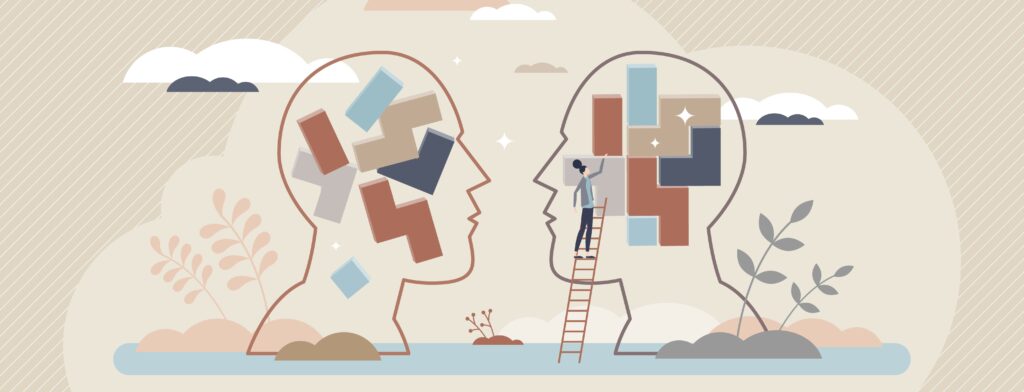Cognitive behavioral therapy (CBT)
Reviewed by Robert Bogenberger, PhD

What is cognitive behavioral therapy?
Cognitive behavioral therapy (CBT) is a form of talk therapy that helps you identify unhelpful or negative thought patterns affecting your emotions and actions. CBT teaches you to challenge unhelpful thoughts (cognition) so you can choose healthier responses to stress (behaviors).


As you investigate the relationship between your thoughts, feelings, and behaviors, you can learn to interrupt cycles of anxiety, depression, and other mental health challenges using tools and techniques to navigate stress in a more self-compassionate way.
The cognitive triangle
The “cognitive triangle” is a way of picturing how our thoughts, feelings, and behaviors (the triangle’s three points) interconnect and shape our experience of the world. When we struggle with anxiety, depression, posttraumatic stress disorder (PTSD), or other mental health disorders, we can feel stuck in specific patterns of the triangle. These patterns may be so ingrained that we aren’t even aware of them until a therapist points them out.
Distressing thoughts → overwhelming emotions → unhelpful behaviors
Imagine a scenario that could make you feel anxious at work: Your boss emails out of the blue asking you to come to her office after lunch. Your anxiety may take you down a familiar pattern of thoughts, feelings, and behaviors:
- Thoughts: “This can’t be good. My boss knows I don’t belong here. I’m getting fired.”
- Emotions: You feel panic, fear, dread, and shame.
- Behaviors: Feeling so upset that you can’t eat, you spend your lunch hour searching for other jobs, convinced you’re going to be laid off and there’s nothing you can do about it.
Distressing thoughts → CBT techniques → steadier emotions → healthier behaviors
CBT can help you reevaluate and change this unhelpful pattern. The guiding idea behind this kind of therapy is that you can learn new behaviors to use when distressing thoughts arise, resulting in calmer emotions and healthier reactions. Over time, unhelpful thoughts will have less power over you or may disappear entirely.
Let’s go back to that email from your boss. Following CBT, your thoughts, feelings, and behaviors might look something like this:
- Thoughts: “I feel a little anxious. That’s okay. This meeting might be about something good, challenging, or trivial. Whatever happens, I know I can handle it.”
- Emotions: You feel brief anxiety followed by calm, steadiness, and self-assuredness.
- Behavior: You take some calming breaths, and then go enjoy your lunch.
Related therapies
CBT shares characteristics and techniques with other types of therapy intended to positively influence your thoughts, feelings, and behaviors. These include:
- Dialectical behavior therapy (DBT)
- Relapse prevention (RP)
- Mindfulness-based cognitive therapy (MBCT)
- Prolonged exposure therapy (PE)
- Integrative behavioral couples therapy (IBCT)
What is CBT used for?
Therapists use CBT for a number of mental health disorders, including:
- Anxiety
- Depression
- Bipolar disorder
- Posttraumatic stress disorder (PTSD)
- Obsessive-compulsive disorder (OCD)
- Eating disorders
- Substance abuse
- Grief
- Phobias
CBT can also help people without a specific disorder who are experiencing a stressful situation or a tough transition. Depending on the frequency of your sessions, it’s possible to make progress in only a few weeks or months of treatment.
How does cognitive behavioral therapy work?
1. Identify a problem/set a goal
The first step in CBT is to figure out what problems you’re facing and how you hope to solve them. It’s important to be specific when identifying those issues and setting goals to address them. For example, a patient with an eating disorder may tell his therapist that he’s losing weight at an unhealthy rate (the problem). Together, he and his therapist can discuss ways to help the patient nourish his body in a healthy way (the goal).
2. Discover your thoughts, emotions, and beliefs
Once you’ve identified a problem, your therapist will help you discover your existing thoughts, emotions, and beliefs about it. They’ll also help you identify the assumptions at the center of most of your thoughts and feelings. These are known as your “core beliefs.”
You can discover your core beliefs through a number of CBT exercises, such as:
- Guided questioning
- Journaling
- Self-talk
- Other forms of “homework” (activities done on your own between therapy sessions)
3. Identify distortions
Once you’ve figure out what sorts of thoughts and beliefs drive your emotions and actions, it’s time to investigate them with your therapist’s help. Your goal isn’t to judge your thoughts and beliefs as “good” or “bad,” but instead to identify whether they’re “true/helpful” or “untrue/unhelpful.”
Untrue or unhelpful thoughts and beliefs are called “cognitive distortions.” These patterns of thought may have served a useful purpose before, but they no longer do. For many patients, cognitive distortions are left over from past protective measures or coping strategies used to survive trauma.
Examples of cognitive distortions include:1
- All-or-nothing thinking
- Overgeneralization
- Mental filtering
- Discounting the positive
- Mind reading
- Fortune telling
- Emotional reasoning
- “Should” statements
- Blaming
- Labeling
- Catastrophizing
Once you identify which thoughts and beliefs no longer serve who you are in the present moment, you can learn to reshape them into truer, more helpful ways of thinking.
4. Reshape unhelpful thoughts and beliefs
Cognitive behavioral therapy offers a variety of exercises and techniques you can use to counter your negative distortions. Examples include:
- Mindfulness: Mindfulness practices can keep you from spiraling into negative thought patterns that get more overwhelming over time. With mindfulness, you can ground yourself in the present moment by using your five senses. You can then bring your awareness to your thoughts and feelings without judging them.
- Exposure: People struggling with PTSD, phobias, or OCD may be triggered by objects, images, or situations that are perfectly safe in reality but cause feelings of stress, fear, or anxiety. By exposing yourself to what you fear with your therapist’s help, you can learn to disconnect your negative emotions or memories from a trigger.
- Self-questioning: When you have a negative or unhelpful thought, you can learn to interrupt your thought pattern by questioning it. CBT can help you identify the cognitive distortions (such as labeling or blaming) behind your unhelpful thought patterns.
- Self-compassion: Many people who struggle with their mental health feel like they can offer grace, love, and forgiveness to everyone except themselves. Self-compassion techniques can help you treat yourself like you would a friend. This helps you learn to see yourself as worthy of love and connection.
What to expect in a CBT session
During your first appointment, your therapist will ask you questions so they can learn more about you and what sorts of problems you may be facing. Feel free to ask your therapist questions as well. It’s important to make sure your therapist is a good fit for your specific situation.
Your sessions will mostly consist of you and your therapist talking about the problems you’re facing and different ways for you to identify and disrupt any distortions. It can be uncomfortable or even distressing to uncover and name the negative beliefs you may hold about yourself—that’s why it’s important to choose a therapist you trust. You need someone who can encourage you to continue with your therapy even when it’s hard.
Eventually you’ll begin to make progress and feel improvement in your daily life. Although your distorted thoughts may never completely go away, you’ll now have the tools you need to respond to them in a healthy way.
Get help now
To find a CBT therapist near you, browse our directory. If you’re in crisis, help is available immediately: Call or text the free, confidential 988 Lifeline at 988. It’s available 24 hours a day, 7 days a week.

About the author
The editorial team at therapist.com works with the world’s leading clinical experts to bring you accessible, insightful information about mental health topics and trends.
Related articles

Interpersonal psychotherapy (IPT)
Interpersonal psychotherapy works to treat mood disorders by improving...

How VR therapy can help you face your fears
Virtual reality therapy can help treat conditions like anxiety, but only with...

Rational emotive behavior therapy (REBT)
Rational emotive behavior therapy helps people identify irrational beliefs that...

Cognitive processing therapy (CPT)
Cognitive processing therapy (CPT) helps people with PTSD identify and resolve...
